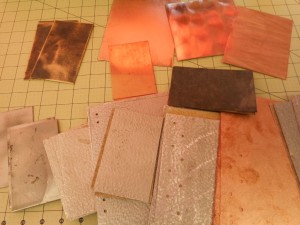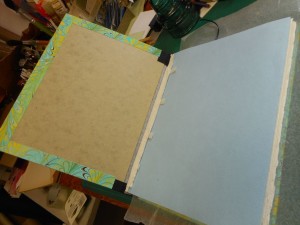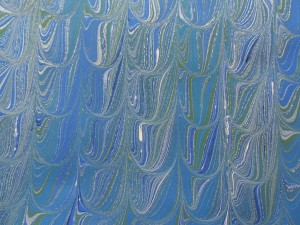One of the most satisfying experiences I have when I’m marbling is hanging a finished sheet and realizing it is perfect. It doesn’t happen as frequently as I’d like, but it does happen. There are so many things that can go wrong and so many variants that sometimes it’s hard to figure out where the problem occurred. After all the papers are dry at the end of a marbling session, the first thing I do is to sort my papers into piles – saleable, usable, disaster and that rarity, perfect.
For my own clarification and maybe to help new marblers, I am going to try to look at the places where marbling can go wrong and maybe how to fix it. This will probably take several blogs and may be interspersed with other commentary.
PAPER
First comes the paper. You can marble almost any kind of paper, but the results will vary. I’ve only had two total disasters. The first was a very slick brochure, both the alum and paint tended to slide off . Some color did stick, but it was very messy. Slick magazine pages are very iffy, they might work, but they might not. The second wipeout was a heavy “cloth-like” paper napkin. It lay down on the tray well, but just wasn’t strong enough to hold the paint. When I lifted it from the marbling tray, it shredded.
Different weight papers may require slightly different techniques. I tend to catch bubbles on heavier papers because they don’t roll down as smoothly. If I switch paper weights, I find I have problems with the first ones until I get into the right rhythm. With anything that doesn’t bend, like mat board, I dunk the starting corner to keep the rest going smoothly. Antique paper, like pages from 19th century books, can be marbled if you handle it gently. It may need to be laid flat on a towel to dry, rather than being hung. Hanging weak paper, of any age, may tear the corners. Although I always rinse my marbling before hanging, I’ve found that a residue of carrageenan remains on the paper which seems to strengthen old paper. Another quirk I’ve noticed is that slightly acidic paper seems to produce brighter and crisper marbling. Almost all the the new paper I buy is acid-free, but I have stashes of print and watercolor paper that belonged to my Mother and they all have some acid content, as do the maps and book pages I use.
For my standard marbling, I use Strathmore or Canson drawing paper. For use in my books, I try to stay within the 90gsm to 120gsm range. For cards, I use standard card stock. I have some lovely pieces on very heavy weight paper, but haven’t figured out a use for them yet, other than framing! When I need a large colored paper, I use Pastel paper, either Strathmore or Canson Mi-Teintes.
ALUM
I’ve read many times that you should not use grocery store alum for marbling, but only buy that expressly labeled for marbling. Guess what? They are right. I had to try some from a bulk food store that was just labeled “alum”, not “pickling alum”. It did work, but I had a lot more papers that had alum streaks than usual.
Problems with alum are pretty easy to spot. If there are grainy, greyish spots or spots where there is washed out color, it’s probably due to an incomplete application of alum. The predominate problem I’ve had with alum, however, is user generated. I use the non-alumed side by mistake.
-
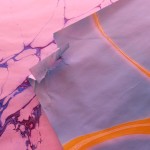
-
Torn corner from weak paper
-
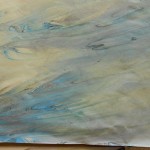
-
No alum, probably wrong side
-
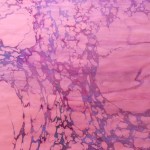
-
Paint washing off due to lack of alum
-
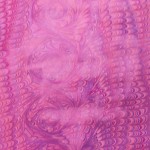
-
Alum spotting
-

CARRAGEENAN
I’ve had few problems related to the carrageenan overall. The proportions are important as is the blending time. I use 2.5 Tbs. per gallon of water and blend for at least one minute. (I have very hard well water so I use bottled distilled water. Most people can use tap water.) It can last for up to a week, but I did have one batch that started breaking down after two days. Sometimes it is hard to distinguish between a paint problem, a carrageenan problem and general contamination. In one particular case, I’m pretty sure it was just the carrageenan, because I mixed a new batch and the next day the same paint was fine. Contamination in the tray can usually be solved by a good skimming. Just be careful to skim only on the top. If you dip too far into the carrageenan, you risk recirculating all sorts of bad stuff that has sunk to the bottom of the tray. Since all marbling takes place only on the top surface, what’s underneath can’t hurt, usually. You can tell that the carrageenan is “worn out” if the problems affect all the colors. It also seems to manifest with globs with squarish sides rather than the rounder dots from paint problems. The only solution for over-used carrageenan is to toss it and start again.
By the way, dirty carrageenan is Okay. In fact, it seems to work better after having a bit of paint in it.
-
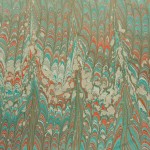
-
Probably carrageenan breakup or severe contamination
-
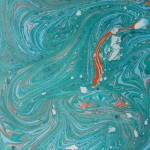
-
Problems with carrageenan or paint?
UPDATE: See my blog on “An Interesting Carrageenan Disaster” for a real problem I encountered. In hindsight, I think I must have mismeasured the carrageenan and added an extra tablespoon.
PAINT
If you are planning to do a lot of marbling or marbling something special, it pays to start with quality paint. I use Golden Fluid Acrylics because of their high pigment to carrier ratio. That means more intense colors even when the paint is thinned. They come in a wide range of colors and in several size bottles. Start with the 1 oz. size. When you are using paint one drop at a time, you can do a lot of papers with 1 oz. Since you want the paint to float easily, avoid any “heavy body” paints. You should also avoid any paints meant for children. The cheaper paints have less pigment and can be unevenly blended causing problems for marblers.
Getting the paints balanced perfectly with your size can be very tricky. One of the most obvious problems is having the paint contract into a tiny ball and drop to the bottom of your tray. This happens when the paint is too thick or heavy in relation to the size. The solution is usually to add more water to the paint, a few drops at a time. Alternatively, a surfactant can be added to the paint. I use Golden’s Acrylic Flow Release. Photo-Flo from Kodak can be used and marbling gall is used with watercolors. Getting colors to spread instead of drop is usually just a matter of patience and trial and error. I haven’t found a solution to the opposite problem, when a single drop of paint fills the entire tray! Reds and yellows are especially prone to spreading. To reduce the spread, you can try to add more paint, but I’ve found it’s easier just to start over with fresh paint and add water just a drop at a time until you have the right consistency. I always mix very small amounts of paint to start so I don’t feel badly if I have to throw some out. Unlike painting, marbling is a matter of drops, not huge amounts.
Some paint will always drop out, at least it always does for me, but at the end of a session, the bottom of your tray should not be coated with a build-up of paint. Some scattered drops are normal.
A common problem I have is the paint granulating or stretching apart into tiny particles. This is especially noticeable when using metallics, but it happens with other colors. I haven’t found a real cure yet, but repeated stirring seems to help keep the pigments in suspension. Just don’t stir so vigorously that you make bubbles. They are a real pain to eliminate.
-
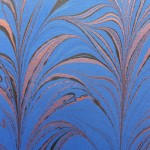
-
Some granulation of the copper
-
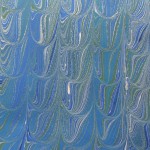
-
Silver granulation
-

-
Granulation
-
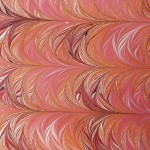
-
More breaking apart
If you click on the photos and examine the larger size, you can see where the paint has begun to break down. The finer I make the lines in the pattern, the more break down occurs. In some instances, like the silver and blue, the effect is gossamer, sparkly strands; in others, it is just a mess! The less you manipulate the colors, the less break down.
USER ERROR
Of course the most frequent source of problems is just me, especially in laying down the paper. All sorts of messes can occur, but air bubbles caught between the paper and the size are my most frustrating problem. I have a gorgeous pattern in the tray and then a big bubble ruins it.
-
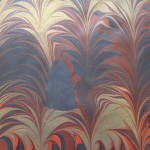
-
Huge air bubble on black paper
-
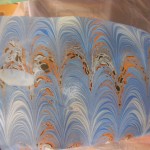
-
Large bubble plus weird brown paint
-
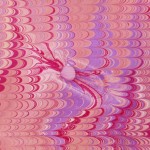
-
Smaller bubble
-
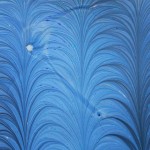
-
Small bubble creating drag lines
Hesitation lines are another problem I have on a regular basis. The lines occur when your paper isn’t placed on the paint in a smooth motion. Where you hesitate or jerk your hands, a line of paint forms. This can be a desired result when you are making a ripple or moire pattern. I frequently have problems with the last corner and there’s a little line right there. Hesitation lines are one of the reasons I don’t usually work with paper larger than 14″ x 17″. I’m short, my arms are short and stretching over a larger tray with longer paper results in lots of dips and lines.
-
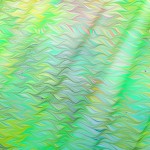
-
Ripples on purpose
-
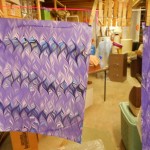
-
“Worm” at top, hesitation line in bottom corner
More examples to come.
To be continued …
Like this:
Like Loading...
